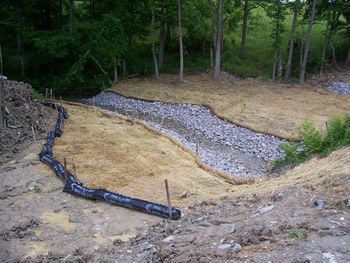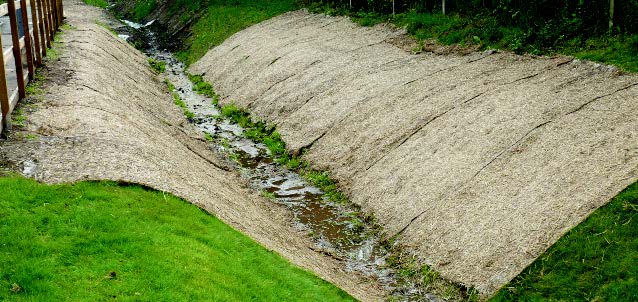Erosion Control
Erosion control is a critical concern for property owners, municipalities, and environmentalists alike. The degradation of soil due to erosion can lead to significant problems, including loss of fertile land, increased flooding, and sedimentation in water bodies. Implementing effective erosion control strategies is essential to mitigate these issues and promote sustainable land management.
In this article, we will explore various strategies for erosion control, focusing on hillside erosion control products, the use of fast-growing grass seed for erosion control, and other essential techniques to protect your land.
Understanding Erosion and Its Impact
Erosion is the process by which soil and rock are removed from the Earth’s surface by wind, water, or other natural agents. While erosion is a natural process, human activities such as construction, deforestation, and agriculture can accelerate it. The consequences of unchecked erosion include:
- Loss of topsoil, which is vital for plant growth.
- Increased risk of landslides and flooding.
- Degradation of water quality due to sedimentation.
- Loss of habitat for plants and wildlife.
To combat these challenges, it is essential to implement effective erosion control measures.

Hillside Erosion Control Products
Hillsides are particularly susceptible to erosion due to the steep gradient, which increases the velocity of runoff and the potential for soil displacement. Here are some effective hillside erosion control products:
Erosion Control Blankets
Erosion control blankets are made from natural or synthetic fibers and are designed to stabilize the soil surface. These blankets provide immediate protection against erosion and help establish vegetation by holding seeds in place. They are particularly useful on steep slopes and areas with loose soil.
Silt Fences
Silt fences are temporary barriers made of geotextile fabric that is installed along the contour of a slope. They are designed to slow down water flow and capture sediment, preventing it from washing away. Silt fences are commonly used in construction sites and areas with disturbed soil.
Coir Logs
Coir logs are biodegradable logs made from coconut fibers. They are placed along the contour of a slope to reduce water flow velocity and trap sediment. Coir logs also provide a medium for vegetation to establish, further stabilizing the soil.
Fast Growing Grass Seed for Erosion Control
Grass is an excellent natural solution for erosion control due to its extensive root system that holds the soil in place. Fast-growing grass seed varieties can quickly establish ground cover, reducing the risk of erosion. Here are some popular fast-growing grass seed options for erosion control:
Annual Ryegrass
Annual ryegrass is a popular choice for erosion control due to its rapid germination and growth. It establishes quickly and provides excellent ground cover, making it ideal for temporary erosion control on disturbed soil.
Perennial Ryegrass
Perennial ryegrass is another effective option for erosion control. It has a slightly slower establishment rate compared to annual ryegrass, but it provides long-term erosion protection. Perennial ryegrass is often used in combination with other grass species for a more resilient ground cover.
Fescue
Fescue grasses, particularly tall fescue and creeping red fescue, are well-suited for erosion control. They have deep root systems that stabilize the soil and are drought-tolerant, making them ideal for slopes and areas with poor soil conditions.
Additional Erosion Control Techniques
In addition to hillside erosion control products and fast-growing grass seed, there are several other techniques that can be employed to manage erosion effectively:
Terracing
Terracing involves creating stepped levels on a slope to reduce water runoff and soil erosion. Each terrace acts as a catchment area, slowing down water flow and allowing it to infiltrate the soil. Terracing is a labor-intensive method but is highly effective for steep slopes.
Mulching
Mulching involves applying a layer of organic or inorganic material on the soil surface to protect it from erosion. Mulch helps retain soil moisture, reduce runoff, and promote vegetation growth. Common mulching materials include straw, wood chips, and gravel.
Planting Ground Cover
Planting ground cover, such as shrubs, vines, and low-growing plants, is an effective way to stabilize soil and reduce erosion. Ground cover plants protect the soil from direct rainfall impact and provide root systems that hold the soil in place.
Installing Retaining Walls
Retaining walls are structures built to hold back soil and prevent erosion on steep slopes. They can be made from various materials, including concrete, stone, and wood. Retaining walls provide structural support and can be combined with vegetation for added stability.
Creating Riprap
Riprap involves placing large stones or rocks along the base of a slope or shoreline to protect against erosion. The rocks absorb and dissipate the energy of flowing water, reducing its erosive force. Riprap is commonly used in areas with high water flow, such as riverbanks and coastal areas.
Vegetative Buffer Strips
Vegetative buffer strips are areas of dense vegetation planted along the contours of a slope or waterway. These strips act as a barrier, trapping sediment and reducing water flow velocity. They also provide habitat for wildlife and improve water quality by filtering pollutants.
Implementing an Erosion Control Plan
Effective erosion control requires a comprehensive plan tailored to the specific conditions of your site. Here are some steps to develop and implement an erosion control plan:
- Assess the Site: Conduct a thorough assessment of the site to identify erosion-prone areas, soil type, slope gradient, and existing vegetation.
- Select Appropriate Measures: Choose a combination of erosion control products and techniques that are suitable for the site’s conditions.
- Develop a Maintenance Plan: Regularly inspect and maintain erosion control measures to ensure their effectiveness. Replace or repair damaged materials as needed.
- Monitor and Adjust: Continuously monitor the site for signs of erosion and adjust the erosion control plan as necessary to address any new challenges.
By implementing a well-thought-out erosion control plan, you can protect your land from the detrimental effects of erosion and promote sustainable land management practices.
Conclusion
Erosion control is essential for preserving soil health, preventing environmental degradation, and ensuring the stability of slopes and water bodies. By utilizing hillside erosion control products, fast-growing grass seed, and other effective techniques, you can successfully mitigate erosion and protect your land. Remember to assess your site, select appropriate measures, and maintain your erosion control plan to achieve the best results.
With the right strategies in place, you can combat erosion and contribute to a healthier, more sustainable environment.




